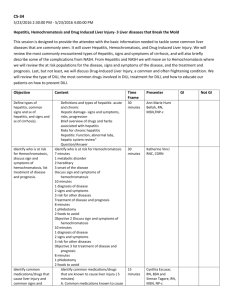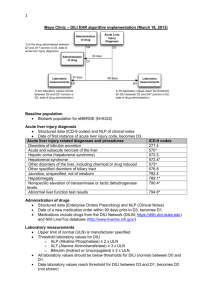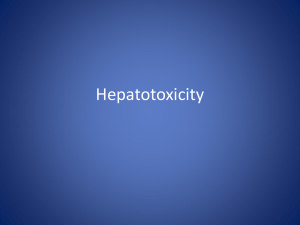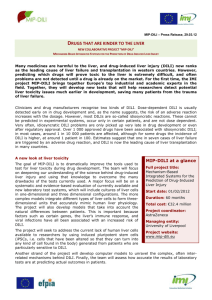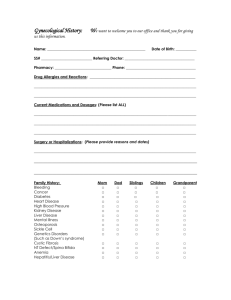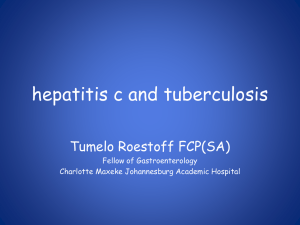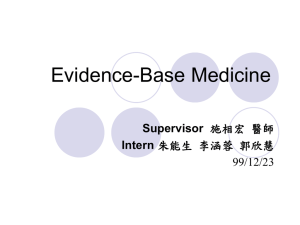Drug-induced liver injury (DILI)
advertisement
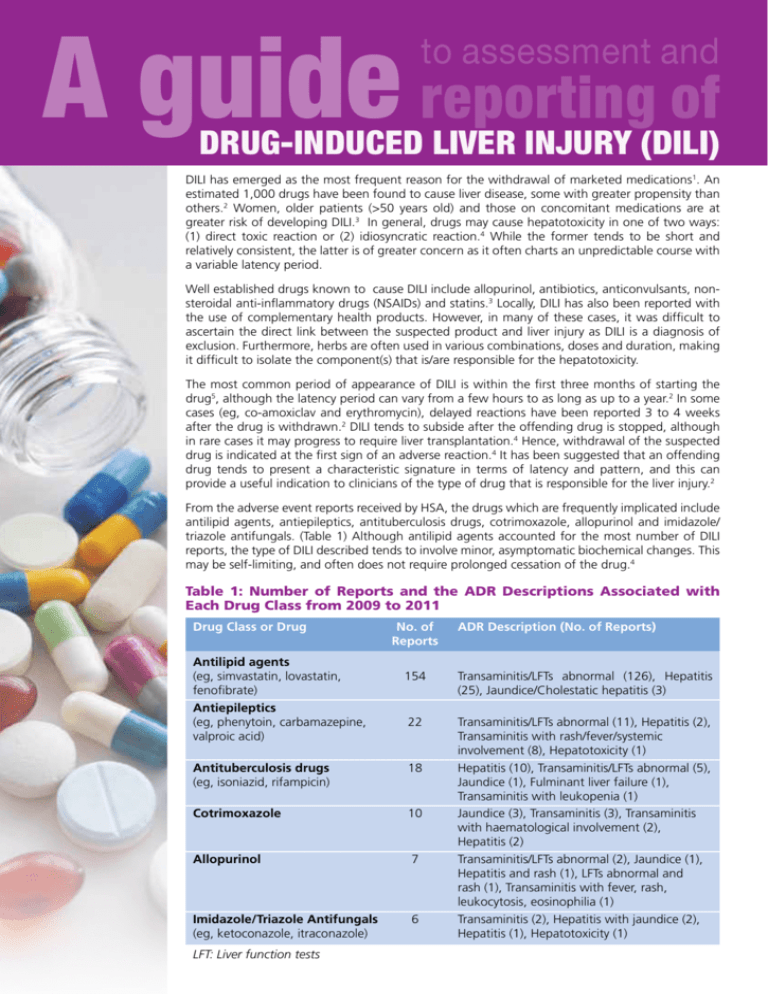
A guide reporting of to assessment and Drug-Induced Liver Injury (DILI) DILI has emerged as the most frequent reason for the withdrawal of marketed medications1. An estimated 1,000 drugs have been found to cause liver disease, some with greater propensity than others.2 Women, older patients (>50 years old) and those on concomitant medications are at greater risk of developing DILI.3 In general, drugs may cause hepatotoxicity in one of two ways: (1) direct toxic reaction or (2) idiosyncratic reaction.4 While the former tends to be short and relatively consistent, the latter is of greater concern as it often charts an unpredictable course with a variable latency period. Well established drugs known to cause DILI include allopurinol, antibiotics, anticonvulsants, nonsteroidal anti-inflammatory drugs (NSAIDs) and statins.3 Locally, DILI has also been reported with the use of complementary health products. However, in many of these cases, it was difficult to ascertain the direct link between the suspected product and liver injury as DILI is a diagnosis of exclusion. Furthermore, herbs are often used in various combinations, doses and duration, making it difficult to isolate the component(s) that is/are responsible for the hepatotoxicity. The most common period of appearance of DILI is within the first three months of starting the drug5, although the latency period can vary from a few hours to as long as up to a year.2 In some cases (eg, co-amoxiclav and erythromycin), delayed reactions have been reported 3 to 4 weeks after the drug is withdrawn.2 DILI tends to subside after the offending drug is stopped, although in rare cases it may progress to require liver transplantation.4 Hence, withdrawal of the suspected drug is indicated at the first sign of an adverse reaction.4 It has been suggested that an offending drug tends to present a characteristic signature in terms of latency and pattern, and this can provide a useful indication to clinicians of the type of drug that is responsible for the liver injury.2 From the adverse event reports received by HSA, the drugs which are frequently implicated include antilipid agents, antiepileptics, antituberculosis drugs, cotrimoxazole, allopurinol and imidazole/ triazole antifungals. (Table 1) Although antilipid agents accounted for the most number of DILI reports, the type of DILI described tends to involve minor, asymptomatic biochemical changes. This may be self-limiting, and often does not require prolonged cessation of the drug.4 Table 1: Number of Reports and the ADR Descriptions Associated with Each Drug Class from 2009 to 2011 Drug Class or Drug No. of Reports Antilipid agents (eg, simvastatin, lovastatin, 154 fenofibrate) Antiepileptics (eg, phenytoin, carbamazepine, 22 valproic acid) Antituberculosis drugs 18 (eg, isoniazid, rifampicin) Cotrimoxazole 10 Allopurinol 7 Imidazole/Triazole Antifungals 6 (eg, ketoconazole, itraconazole) LFT: Liver function tests ADR Description (No. of Reports) Transaminitis/LFTs abnormal (126), Hepatitis (25), Jaundice/Cholestatic hepatitis (3) Transaminitis/LFTs abnormal (11), Hepatitis (2), Transaminitis with rash/fever/systemic involvement (8), Hepatotoxicity (1) Hepatitis (10), Transaminitis/LFTs abnormal (5), Jaundice (1), Fulminant liver failure (1), Transaminitis with leukopenia (1) Jaundice (3), Transaminitis (3), Transaminitis with haematological involvement (2), Hepatitis (2) Transaminitis/LFTs abnormal (2), Jaundice (1), Hepatitis and rash (1), LFTs abnormal and rash (1), Transaminitis with fever, rash, leukocytosis, eosinophilia (1) Transaminitis (2), Hepatitis with jaundice (2), Hepatitis (1), Hepatotoxicity (1) With cotrimoxazole, DILI generally presents as acute hepatitis accompanied by eosinophilia, rash and other features of a hypersensitivity reaction. The prevailing biochemical and histological presentation is acute hepatocellular necrosis, although cholestatic features are quite common. The latency period is usually several weeks.4 Allopurinol has caused liver injury ranging from raised liver enzymes to hepatitis with hypersensitivity features, and sometimes with systemic involvement. Granulomatous hepatitis and hepatic necrosis have also been reported. Symptoms often develop within 1 to 4 weeks of receiving treatment.4,6 Isoniazid may cause transient increases in liver enzymes within the first few weeks of therapy in what appears to be an adaptive response to a toxic metabolite of the drug. This tends to be self-limiting, although some patients, particularly the elderly, may develop progressive liver damage. A similar profile is seen with rifampicin. Discontinuation of these drugs is recommended if AST values are over 3 times the upper limit of normal (ULN) with symptoms, or 5 times the ULN without symptoms. Re-introduction of the drug, if assessed as necessary, should only be done after LFTs normalise and symptoms resolve, starting with low doses and increasing gradually.4,6 Antifungals (eg, ketoconazole, fluconazole) have been associated with liver injury, ranging from transient elevations in liver enzymes to rare life-threatening hepatotoxicity. Symptoms generally appear within 6 weeks of initiation of therapy.6 In the case of oral ketoconazole, the risk of hepatotoxicity increases if it is given for more than 14 days.7 In view of this, the topical route should be preferred over oral ketoconazole for superficial fungal infections.7 When to suspect DILI? DILI should be suspected if it has reached any of the following thresholds at any point in time of the clinical event: ALT ≥ 3 times ULN or above patient’s baseline or ALP ≥ 2 times ULN or above patient’s baseline Any suspected case of DILI which does not improve with drug cessation should be referred to a specialist/tertiary centre. ALT: Alanine aminotransferase; ALP: Alkaline phosphatase; ULN: Upper limit of normal Patients that meet the above DILI criteria will then undergo further characterisation based on the pattern of liver injury, causality assessment, severity and chronicity. In defining the pattern of DILI, the most common presentations of DILI are hepatocellular, cholestatic and mixed, which should be defined on the basis of biochemical criteria using the R ratio: ALT/ULN R= ALP/ULN The R ratio is calculated by dividing the ALT by the ALP, using multiples of the ULN for both values. Thus, it is the relative pattern of ALT and/or ALP elevation that denotes the type of DILI. A relatively elevated ALT over ALP level suggests a hepatocellular pattern of DILI, while the reverse suggests a cholestatic pattern. R ≥ 5 Hepatocellular pattern of DILI 2 < R < 5 Mixed pattern of DILI R ≤ 2 Cholestatic pattern of DILI It is important to note that the values used to calculate the R ratio should be from the same day, and should be from the initial blood test results following the onset of liver injury. Managing and reporting a suspected adverse event Because DILI is often a presumptive diagnosis and many other liver diseases produce a similar clinicopathologic picture, it may be hard to establish causality between a drug and subsequent liver injury. Physicians are advised to: n Establish baseline status before prescribing potentially hepatotoxic drugs, n Follow-up with periodic checks to monitor for signs of DILI, and n Minimise patients’ exposure to these drugs by using the lowest effective dose and choosing topical over systemic routes of administration whenever possible A detailed adverse event report will aid in the assessment of causality and increase inter-observer accuracy, thereby facilitating the detection of signals associating a drug and an adverse reaction. What relevant information should I include when reporting an adverse event associated with the liver? Other than the essential information in an Adverse Drug Reaction (ADR) report, the following information should be included when filing an ADR report involving the liver: n All concurrent drugs and dosages (including complementary medicines, consumed at the same time and/or 3 months before) n Start and stop dates of all drugs n Past medical history (particularly chronic liver diseases) n Relevant laboratory results (eg, liver function tests – including baseline, serology markers or other diagnostic tests for viral hepatitis or any chronic liver diseases) n Any alcohol use n Drug dechallenge/rechallenge (if any) and associated outcomes The Adverse Drug Reaction (ADR) reporting form should be submitted to: Vigilance Branch/Health Products Regulation Group Health Sciences Authority Phone: (65) 6866 3538 Fax: (65) 6478 9069 OR Email to HSA_productsafety@hsa.gov.sg OR Online reporting at http://www.hsa.gov.sg/ae_online Histomicrographs 1 Normal liver 2 Cholestasis due to Traditional Chinese Medicine: Lobular inflammation with bile [green arrow], ballooning degeneration [black arrow] and steatosis [blue arrow] 3 Hepatic granuloma [arrow] (Common drug causes include allopurinol, phenytoin) 4 Necrosis with eosinophilia due to anti-tuberculosis medication: Area of necrosis with inflammatory cell infiltrate including scattered eosinophils [arrow] Acknowledgement The above diagnostic guide was developed by the Health Sciences Authority in consultation with A/Prof Chow Wan Cheng, Senior Consultant and Dr Tan Hui Hui, Consultant, Department of Gastroenterology & Hepatology, SGH. HSA would also like to thank Dr Wan Wei Keat, Consultant, and Dr Lim Kiat Hon, Senior Consultant, Department of Pathology, SGH, for kindly providing histomicrograph 1-3 and histomicrograph 4 respectively. Professional discretion and judgment should be exercised in relying on reports published under HSA’s AE monitoring programme due to a number of factors such as the reports being based on limited or incomplete data, variable degree of under-reporting and pattern of usage of the product being reported on etc. References 1 2 3 4 5 6 7 Bissell DM, Gores GJ, Laskin DL, et al. Drug-Induced liver injury: Mechanisms and test systems. Hepatology, 2001; 33(4): 1009-1013 Kaplowitz. Drug-induced liver injury. Clin Infect Dis, 2004; 38(Suppl 2): S44-S48. Maddrey WC. Drug-induced hepatotoxicity 2005. J Clin Gastroenterol, 2005; 39(Suppl2): S83-S89. Braunwald E, Fauci AS, Kasper DL, et al. Harrison’s Principles of Internal Medicine 15th Edition. McGraw Hill; 2003. Aithal GP, Watkins PB, Andradr RJ, et al. Case definition and phenotype standardisation in drug-induced liver injury. Nature, 2011; 89(6) 806-815. Micromedex® Healthcare Series [Internet database]. Greenwood Village, CO: Thomson Reuters (Healthcare) Inc. Updated periodically Joint Formulary Committee. British National Formulary. 53rd ed. London: British Medical Association and Royal Pharmaceutical Society of Great Britain; 2007. Vigilance Branch, Health Products Regulation Group, Health Sciences Authority 11 Biopolis Way, #11-01, Helios, Singapore 138667 Tel: (65) 6866 3538 Fax: (65) 6478 9069 Website: http://www.hsa.gov.sg Email: HSA_productsafety@hsa.gov.sg
